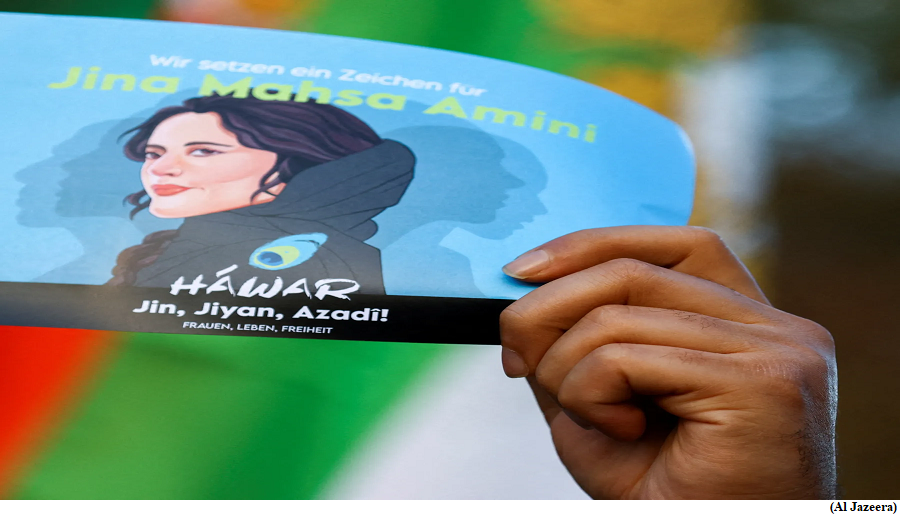EU Human Rights Prize (Miscellaneous)

Why in news?
- Mahsa Amini, the 22-year-old Kurdish-Iranian woman was awarded the European Union’s top human rights prize recently.
- She died in police custody in Iran in 2022, sparking worldwide protests against the country’s conservative Islamic theocracy.
About the prize:
- The EU award, named for Soviet dissident Andrei Sakharov, was created in 1988 to honour individuals or groups who defend human rights and fundamental freedoms.
- Sakharov, a Nobel Peace Prize laureate, died in 1989.
Other finalists:
- Other finalists in 2023 included Vilma Núñez de Escorcia and Roman Catholic Bishop Rolando Álvarez; two emblematic figures in the fight for the defence of human rights in Nicaragua and a trio of women from Poland, El Salvador and the United States leading a fight for “free, safe and legal abortion”.
Sanctions imposed:
- Amini died on September 16, 2022, after she was arrested for allegedly violating Iran’s mandatory headscarf law.
- Women have played a leading role in the protests, with many publicly removing the compulsory Islamic headscarf, known as the hijab.
- The EU has imposed sanctions on Iranian officials and organisations including ministers, military officers and Iran’s morality police for human rights abuses over the protests.
Way Forward:
- The award ceremony will take place on December 13
Little Ice Age (LIA) was wet (moist) and was not uniformly cold and dry
(GS Paper 3, Science and Technology)
Why in news?
- A new study of the Little Ice Age (LIA), a global climatic event, between CE 1671-1942, which shows significant variations of rainfall patterns during that age, challenges the conventional notion of a uniformly cold and dry climate with reduced monsoon rainfall during the LIA.
 was wet.png)
Dynamics in Western Ghats:
- The Western Ghats experiences both the southwest summer monsoon (SWM) during June to September and the northeast winter monsoon (NEM) during October to December.
- Understanding the vegetation dynamics and corresponding hydro-climate variability from such an area, which was influenced by the both the SWM and NEM, could be crucial in understanding the monsoonal variability during the last millennium.
How study was conducted?
- A study of pollen-based vegetation dynamics and contemporary climate change and monsoonal variability between CE 1219-1942 was reconstructed from the Western Ghats by the Birbal Sahni Institute of Palaeosciences (BSIP). It showed the record of moist (wet) LIA.
- The scientists scouted core sediment samples from the Honnamanakere Lake in Karnataka and analysed pollen accumulated in them to reconstruct the vegetation-based climate change and monsoonal variability during CE 1219-1942 from the Western Ghats.
Key observations:
- Moist/semi-evergreen–dry tropical deciduous forests were mainly recorded from the study area.
- Their study showed that record of the signature of moist conditions during Little Ice Age (LIA) from the Western Ghats, India, probably due to the increased NEM. The moist (wet) LIA, moreover, shows the hydro-climatic contrast.
- They suggested that northward movement of the Inter Tropical Convergence Zone (ITCZ), positive temperature anomalies, increased sunspot numbers and high solar activity could be driving the climate change and increased SWM.
- They attributed the weakest phase of the ISM across the Indian subcontinent during the LIA, in general, to the southward shift of the ITCZ, resulting from increased northward energy flux across the equator, during a cold northern hemisphere.
Way Forward:
- The high-resolution palaeoclimatic records generated in the present study could be helpful in developing paleoclimatic models for future climatic predictions and also for a scientifically sound policy planning.
- Knowledge and understanding of the climate change and the Indian Summer Monsoon (ISM) variability during the Holocene could be of immense interest to strengthen the understanding of the present ISM-influenced climatic conditions, as well as of possible future climatic trends and projections.
A draft menstrual hygiene policy is finally out
(GS Paper 2, Health)
Why in news?
- The Centre’s Menstrual Hygeine Policy was recently hosted online for comments from the public.
- The Menstrual Hygiene Policy officially aims at addressing the long-standing challenges associated with menstruation in our country.

Why this policy?
- Historically, this biological phenomenon has been overlooked, resulting in negative impact on girls, women, families and the environment.
- India, with its vast and diverse population, acknowledges the critical importance of this issue and places great emphasis on framing a comprehensive menstrual hygiene policy.
- This policy is essential for effectively addressing the needs of all who menstruate and promote a positive transformation within society.
Why it matters?
- Indeed, given the population figures, any problem is bound to be daunting, because of the sheer number of people it affects.
- The number of women who have no access to the restroom, access to napkins, or other menstrual products is staggering. It is a reality.
- First and foremost it affects the mental health of the women, impacts on their confidence, development and So, if there is a policy that will be seriously implemented, and improve women’s access to hygiene and privacy, then it is a welcome measure.
Approach:
- The policy will adopt a “life cycle” approach and attempt to provide comprehensive support throughout the menstrual journey; from menarche to menopause. So, when and if, fully implemented, it might just break down the barriers that women and girls face today.
- The Menstrual Hygiene Policy document online reiterates its commitment to align with India’s aspirations to achieving the Sustainable Development Goalsparticularly in relation to good health and well-being, quality education, gender equality, and clean water and sanitation.
- It has also pledged to make menstrual products more accessible and affordable, in addition to creating hygienic toilets in public areas, workplaces, and schools.
Way Forward:
- The policy vows to serve as a catalyst to raise awareness, challenge societal norms and foster a society that embraces menstrual hygiene as a natural and normal part of life.



 was wet.png)
